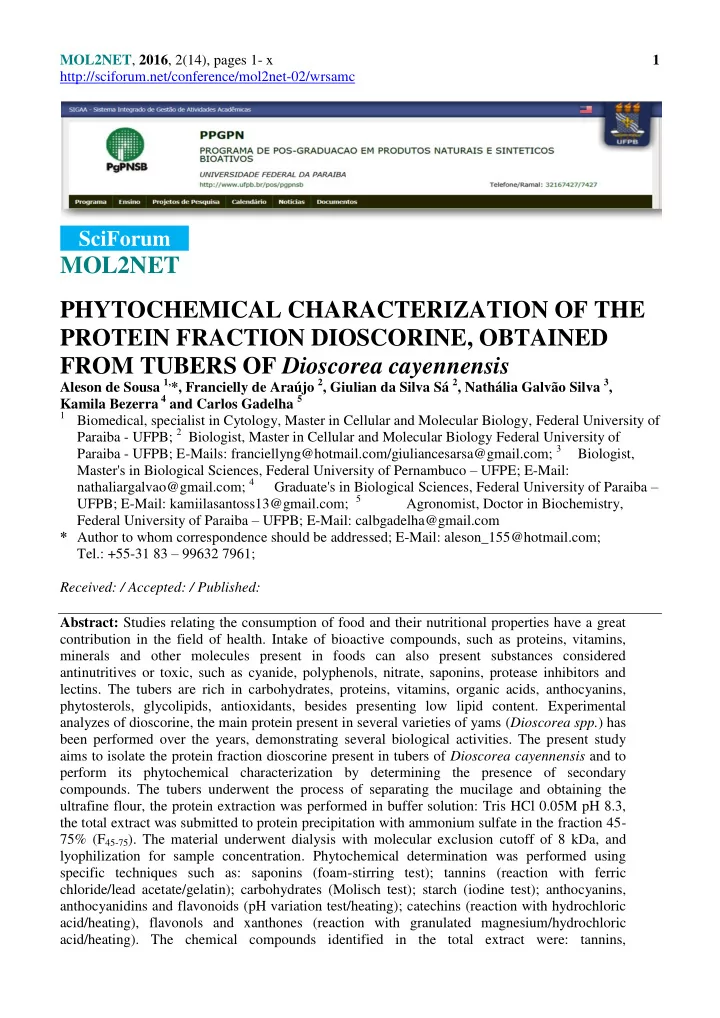

MOL2NET , 2016 , 2(14), pages 1- x 1 http://sciforum.net/conference/mol2net-02/wrsamc SciForum MOL2NET PHYTOCHEMICAL CHARACTERIZATION OF THE PROTEIN FRACTION DIOSCORINE, OBTAINED FROM TUBERS OF Dioscorea cayennensis Aleson de Sousa 1, *, Francielly de Araújo 2 , Giulian da Silva Sá 2 , Nathália Galvão Silva 3 , Kamila Bezerra 4 and Carlos Gadelha 5 1 Biomedical, specialist in Cytology, Master in Cellular and Molecular Biology, Federal University of Paraiba - UFPB; 2 Biologist, Master in Cellular and Molecular Biology Federal University of Paraiba - UFPB; E-Mails: franciellyng@hotmail.com/giuliancesarsa@gmail.com; 3 Biologist, Master's in Biological Sciences, Federal University of Pernambuco – UFPE; E-Mail: nathaliargalvao@gmail.com; 4 Graduate's in Biological Sciences, Federal University of Paraiba – UFPB; E-Mail: kamiilasantoss13@gmail.com; 5 Agronomist, Doctor in Biochemistry, Federal University of Paraiba – UFPB; E-Mail: calbgadelha@gmail.com * Author to whom correspondence should be addressed; E-Mail: aleson_155@hotmail.com; Tel.: +55-31 83 – 99632 7961; Received: / Accepted: / Published: Abstract: Studies relating the consumption of food and their nutritional properties have a great contribution in the field of health. Intake of bioactive compounds, such as proteins, vitamins, minerals and other molecules present in foods can also present substances considered antinutritives or toxic, such as cyanide, polyphenols, nitrate, saponins, protease inhibitors and lectins. The tubers are rich in carbohydrates, proteins, vitamins, organic acids, anthocyanins, phytosterols, glycolipids, antioxidants, besides presenting low lipid content. Experimental analyzes of dioscorine, the main protein present in several varieties of yams ( Dioscorea spp. ) has been performed over the years, demonstrating several biological activities. The present study aims to isolate the protein fraction dioscorine present in tubers of Dioscorea cayennensis and to perform its phytochemical characterization by determining the presence of secondary compounds. The tubers underwent the process of separating the mucilage and obtaining the ultrafine flour, the protein extraction was performed in buffer solution: Tris HCl 0.05M pH 8.3, the total extract was submitted to protein precipitation with ammonium sulfate in the fraction 45- 75% (F 45-75 ). The material underwent dialysis with molecular exclusion cutoff of 8 kDa, and lyophilization for sample concentration. Phytochemical determination was performed using specific techniques such as: saponins (foam-stirring test); tannins (reaction with ferric chloride/lead acetate/gelatin); carbohydrates (Molisch test); starch (iodine test); anthocyanins, anthocyanidins and flavonoids (pH variation test/heating); catechins (reaction with hydrochloric acid/heating), flavonols and xanthones (reaction with granulated magnesium/hydrochloric acid/heating). The chemical compounds identified in the total extract were: tannins,
carbohydrates, saponins, flavones, flavonols and xanthones, the protein fraction did not show any phytochemical compound. Therefore, the isolated protein fraction of tubers of D. cayennensis showed no influence of secondary metabolites on their biological activities, being a target for the synthesis of natural products, considering their biotechnological and pharmaceutical importance. Keywords: dioscorine, Dioscorea cayennensis , proteins, yam, phytochemical 1. Introduction The chemical substances present in (B3), pyridoxine (B6) and ascorbic acid (C). food, the nutrients, have crucial functions for They also have anthocyanins, phytosterols, living things such as growth, maintenance and glycolipids and antioxidants, besides having low cell repair (STIPANUK; CAUDILL, 2013). lipid content (RAMOS; RAMOS; HIANE, Currently, studies relate the consumption of 1997). Experimental analyzes of the dioscorine, foods to the nutritional and functional properties the main protein present in several species of the they offer to human and animal health, through genus Dioscorea, have been made over the years the ingestion/absorption of biomolecules, such as by several researchers; in these, proteins, carbohydrates, lipids, vitamins and immunolocalization tests, showed that dioscorine minerals. However, some biomolecules present accumulates mainly in the vacuoles of plant cells in these foods may also present substances of tubers (CONLAN et al., 1997). Therefore, the considered antinutritives and/or toxic, such as objective of the present study was to isolate the cyanide, polyphenols, nitrate, oxalic acid, protein fraction dioscorine (PFD) present in saponins, protease inhibitors and lectins (SILVA Dioscorea cayennensis tubers and to perform et al., 2010; ARMOUR et al., 1998). Among their phytochemical characterization by these foods, rhizomes and tubers are usually rich determining the presence of secondary in carbohydrates, proteins, vitamins, minerals compounds in the protein fraction. and organic acids. Among the vitamins, is cited mainly thiamine (B1), riboflavin (B2), niacin 2. Results and Discussion isolation/purification share similarities between them, since all use protein extraction with buffer Protein Extraction and PFD Obtainment Due to the presence of high Tris 0.05M pH 8.3, followed by precipitation carbohydrate contents, the sample required with ammonium sulfate, to obtain a specific complex processing, with fraction (F 45-75 ). It is well known in the literature separation/precipitation steps to obtain a protein that tubers of amylaceous species, such as D. rich material, according to Guerreiro (2002). The cayennensis , as reserve structures, can take interferers present in yam mucilage represented advantage of edaphoclimatic variations, to about 60% of the tuber composition. The initial survive and transform their organic content by mass of the UF had a yield of 40%, used in the modifying the structures of their molecules accomplishment of protein extraction to obtain (ZANONLL, 2009; DIOP; CALVERLEY, the PFD. 1998). The isolation steps for obtaining PFD are . summarized in Table 1. In this, it is found that Phytochemical Characterization of PFD the steps used allowed a yield of 16% compared The application of qualitative methods in to the initial product UF. In practice, to obtain phytochemical prospecting is relevant because it 1.0 mg of lyophilized PFD it was necessary to allows the initial screening with a lower cost repeat the method about 6 times. This result is in (AYOOLA et al., 2008). Some constituents of line with those previously used for PFD isolation plant extracts may present specific biological by Conlan et al. (1997), Lu et al. (2012) and Liao activities, as is the case of saponins (hemolytic et al. (2006), which obtained the isolation of the activity, anti-inflammatory, antifungal, same protein fraction in other species of the same antibacterial, antimicrobial, antiparasitic, genus. Although conducted in different species cytotoxic and antitumor) (SPARG; LIGHAT; of the genus Dioscorea, the process of VAN STADEN, 2004); Catechins, flavones,
Recommend
More recommend